Convair F-102 Delta Dagger Videos
More Convair F-102 Delta Dagger Videos 1 2 3 - Convair F-102 Delta Dagger Pictures
|
Loading...
|
|
|
Loading...
|
|
Convair F-102 Delta Dagger Documentary
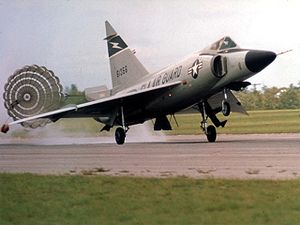 Picture
- F-102 from the 125th Fighter Interceptor Group, Florida Air National Guard, deploys braking parachute
Picture
- F-102 from the 125th Fighter Interceptor Group, Florida Air National Guard, deploys braking parachute
Role - Interceptor aircraft
Manufacturer - Convair
First flight - 24 October 1953
Introduced - April 1956
Retired - 1976, USAF
1979, foreign users
1986, target drones
Primary users - United States Air Force, Greece, Turkey
Number built - 1,000
Unit cost - US$1.2 million[1]
Developed from - Convair F-92
Variants - F-106 Delta Dart
The Convair F-102 Delta Dagger was a US interceptor aircraft built as part of the backbone of the United States Air Force's air defenses in the late 1950s. Entering service in 1956, its main purpose was to intercept invading Soviet bomber fleets.
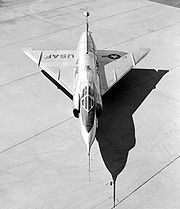 Picture: The YF-102 - Note the
straight sided fuselage
Picture: The YF-102 - Note the
straight sided fuselage
The F-102 was the first supersonic interceptor and first operational delta wing fighter of the USAF. It used an internal weapons bay to carry both guided missiles and rockets. As originally designed, it could not achieve Mach 1 supersonic flight until redesigned with area ruling. The F-102 replaced subsonic types such as the F-89 Scorpion, and by the 1960s, it saw limited service in Vietnam in bomber escort and ground attack roles.
It was supplemented by F-101 Voodoos and, later, by F-4 Phantom IIs. Many of the F-102s were transferred to United States Air National Guard duty by the mid-to-late 1960s, and the type was retired from operational service in 1976. The follow-on replacement was the Mach 2 class F-106 Delta Dart which was an etensive redesign of the F-102.
Design and development
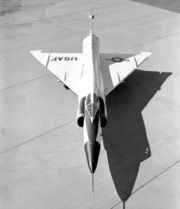 Picture:
The YF-102A - Note the wasp waisted fuselage to conform to the area rule
Picture:
The YF-102A - Note the wasp waisted fuselage to conform to the area rule
The F-102 was developed from the F-92A delta wing research aircraft of the late 1940s. The Air Force took a new approach in putting out the request for proposals for an operational interceptor, considering both the aircraft and armament together in what became known as a "weapon system". While the contract for the comple fire-control system for the new fighter was awarded to Hughes Aircraft, for its MA-1 system,[2] a Request for proposal for Project M-1554 for the airframe was issued on 18 June 1950, and in January 1951, si manufacturers responded, of which Convair, Lockheed and Republic were chosen to proceed with design. The development of three different designs was too epensive and in November, only Convair was allowed to continue with its Model 8-80. To speed development, it was proposed to equip the prototypes and pre-production aircraft with the less-powerful Westinghouse J40 turbojet, while the definitive production version, referred to as the "Ultimate Interceptor" would be powered by the Wright J67, a licensed derivative of the Bristol-Siddeley Olympus which was still in development.[3] Continued delays to the J67 and the MA-1 fire control system led to the decision to place an interim aircraft with the J40 and a simpler fire control system into production as the F-102A "Interim Fighter", while the version with the final engine and fire control system became the F-102B. The failure of the J40 led to the Pratt & Whitney J57 being substituted for the prototypes and F-102As.[4][5]
The prototype YF-102 made its first flight on 24 October 1953, but was lost to an accident nine days later. The second aircraft flew on 11 January 1954, confirming a dismal performance. Transonic drag was much higher than epected, and the aircraft was limited to Mach 0.98 (i.e. subsonic), with a ceiling of 48,000 ft (14,630 m), far below the requirements.[6]
To solve the problem and save the F-102, Convair embarked on a major redesign, incorporating the recently discovered area rule, while at the same time simplifying production and maintenance. The redesign entailed lengthening the fuselage by 11 ft (3.35 m) and ,"pinched" at the mid section (dubbed the "Coke Bottle configuration", with two large fairings on either side of the engine nozzle, with revised intakes and a new, narrower canopy. A more powerful model of J57 was fitted, and the aircraft structure was lightened.[7][8]
The first revised aircraft, designated YF-102A flew on 20 December 1954, 118 days after the redesign started, eceeding Mach 1 the net day.[8] The revised design demonstrated a speed of Mach 1.22 and a ceiling of 53,000 ft (16,154 m), which was sufficient for the Air Force to allow production of the F-102.[9]
The production F-102A had the Hughes MG-3 fire control system, later upgraded in service to the MG-10. It had a three-segment internal weapons bay under the fuselage for air-to-air missiles. Initial armament was three pairs of GAR-1 Falcon missiles, a mi of infrared and semi-active radar homing. The doors of the two forward bays each had tubes for 12 2.75 in (70 mm) FFAR rockets (for a total of 24). The F-102 was later upgraded to allow the carriage of a GAR-11 Nuclear Falcon missiles in the center bay. The larger size of this weapon required redesigned center bay doors with no rocket tubes. Plans were considered to fit the MB-1 Genie nuclear rocket to the design, but it was never adopted.
Because of the changes that had to be made in redesigning the aircraft with the area rule in mind, the ambitious plan to manufacture the production aircraft on the prototype tooling had to be abandoned; two-thirds of the 60,000+ pieces of tooling had to be scrapped or heavily modified.
To train F-102A pilots, the TF-102A trainer was developed, with 111 eventually manufactured. The aircraft was fitted with a side-by-side cockpit to facilitate ease of pilot training. This required a redesign of the cockpit and nose incorporating a set of vorte generators on the top of the cockpit to prevent flow separation under certain circumstances, and repositioning of the intake ducts. Despite the many changes, the aircraft was combat-capable, although this variant was predictably slower, only reaching subsonic speeds in level flight.[10]
The F-102's intended successor was the improved F-102B "Ultimate Fighter". The design, which had the originally intended J67 engine replaced
by a Pratt & Whitney J75 underwent so many aerodynamic changes including a variable-geometry inlet design that it essentially became an entirely
new aircraft and hence was redesignated F-106 Delta Dart. Convair would also use a delta-wing in the Mach 2 class B-58 Hustler bomber.
Operational history
The first operational service of the F-102A was with the 327th Fighter-Interceptor Squadron at George Air Force Base, in April 1956, and eventually a total of 889 were built. The F-102's official name, "Delta Dagger" was never used in common parlance, with the aircraft being universally known as the "Deuce." The TF-102 was known as the "Tub" because of its wide fuselage.
During the time the F-102A was in service, several new wing designs were used to eperiment with the application of increased conical camber to the wings. Ultimately, a design was selected that actually increased elevon area, reduced takeoff speed, improved the supersonic L/D ratio and increased the aircraft's ceiling to 56,000 ft (17,069 m). A modification was required to the landing gear doors due to the wing redesign.
The USAF Air Defense Command had F-102 Delta Daggers in service in 1960 and the type continued to serve in large numbers with both Air Force and Air National Guard units well into the 1970s. George W. Bush, later President of the United States, flew the F-102 in the 147th Fighter Interceptor Group based at Ellington AFB in Houston, T as part of his Teas Air National Guard service from 1968 to 1972.[11]
Vietnam service
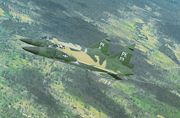 Picture:
Jungle camouflage F-102As of the 509th FIS over Vietnam, November 1966.
Picture:
Jungle camouflage F-102As of the 509th FIS over Vietnam, November 1966.
The F-102 served in Vietnam, flying fighter patrols and serving as bomber escorts. A total of 15 aircraft were lost in Vietnam: one to air-to-air combat,[12] several to ground fire and the remainder to accidents.
Initially, F-102 detachments began to be sent to bases in Southeast Asia in 1962, when radar contacts that were detected by ground radars were thought
to possibly be North Vietnamese Il-28 "Beagle" bombers, which was considered a very credible threat during that time period. F-102s were sent
to Thailand and other nearby countries to intercept these aircraft if they threatened South Vietnam at any time.
Jungle camouflage F-102As of the 509th FIS over Vietnam, November 1966.
Later on, B-52 strikes, codenamed ARC LIGHT, were escorted by F-102s based in the theater. It was during one of these missions that an F-102 was shot down by a North Vietnamese MiG-21 using an AA-2 Atoll heat-seeking missile. The MiGs approached undetected, and one of the F-102s was hit by an air to air missile, which did not eplode immediately, but remained in the aft end of the aircraft causing stability problems. As the pilot reported his mechanical problem to his wingman, the wingman observed the damaged Delta Dagger eplode in mid-air, killing the pilot.[13] The other F-102 pilot managed to shoot off some AIM-4s at the fleeing MiG-21s, but no hits were recorded. This was the only air-to-air loss for the F-102 during the Vietnam War.
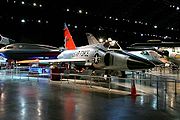 Picture:
F-102A in the Cold War Gallery of the National Museum of the United States Air Force
Picture:
F-102A in the Cold War Gallery of the National Museum of the United States Air Force
The F-102 was tried with limited success for several years in the air-to-ground role, although neither the aircraft nor training were designed for the role.[14] The interceptor was equipped with 24 2.75 in (70 mm) FFARs in the fuselage bay doors. These could be used to good effect against various types of North Vietnamese targets in daylight. At night it was less dangerous to use heat-seeking Falcon missiles in conjunction with the F-102's nose-mounted IRST (Infrared Search & Track) on night time harassment raids along the Ho Chi Minh trail.
Operations with both the F-102A and TF-102A two-seater (which was used in a Forward Air Control role because its two seats and 2.75 in/70 mm rockets offered good versatility for the mission) in Vietnam until 1968 when all F-102 aircraft were sent back to the United States.
Later use
In 1973, si aircraft were converted to target drones as QF-102A and later PQM-102 series, simulating MiG-21s. This began a program where hundreds of F-102s were converted for use as target drones for F-4 and F-106 aircraft as well as later F-15 aircraft and testing of the US Army's Patriot missile system. Some F-102As were configured to accommodate a single AIM-26 Super Falcon in each side bay in lieu of the conventional 2 AIM-4 Falcons.
The F-102 and TF-102 were eported overseas to both Turkey and Greece. The Turkish F-102s saw combat missions during the 1974 Turkish invasion of Cyprus. There have been claims of air combat between Greek F-5s and Turkish F-102s above the Aegean Sea during the Turkish invasion. A Greek internet website editor, Demetrius Stergiou, claims that the Greek F-5s had shot down two Turkish F-102s, while the Turkish side has claimed that their F-102s had shot down two Greek F-5s;[15] however, both Greece and Turkey have officially denied any losses. Three days after the Turkish invasion began, the Greek military junta in Athens collapsed on 23 July 1974. The F-102 was finally retired from both of those air forces in 1979.
The F-102 left US service in 1976, while the last PQM-102 drone was epended in 1986. No F-102s remain in flyable condition today although many can be seen at museums.
Variants
YF-102
Prototypes. Non area-ruled fuselage. Powered by 14,500 lbf (64.5 kN) J57-P-11, two built.
YF-102A
Area-ruled prototypes. 16,000 lbf (71.2 kN) J57-P-23. Four converted from pre-production aircraft.
F-102A
Production Model. Initial eight pre-production aircraft built with non-area ruled fuselage. Remainder (879) with area ruled fuselage.
TF-102A
Two-seat training version, 111 built
F-102B
The original designation of the F-106A
F-102C
Proposed tactical attack version with J57-P-47 engine. Two converted As as YF-102C engineering test beds.[16]
QF-102A
Target drones converted from the F-102A. Si built.[17]
PQM-102A
Unpiloted target drones. 65 converted.[17]
PQM-102B
Revised target drone conversion, capable of being flown remotely or by pilot in cockpit. 146 converted.[17]
Operators
Greece
- Hellenic Air Force
Turkey
- Turkish Air Force
United States
- United States Air Force
Survivors
Below is a partial list of museums or locations with an F-102 Delta Dagger on display:
- YF-102A,serial No: 53-1787 in the Air Park at Jackson Barracks Military Museum, New Orleans, LA
- YF-102A,serial No: 53-1788, Carolinas Aviation Museum, Charlotte, NC formerly on display at Florence, SC
- F-102A, AF Serial No: 54-1405, Strategic Air and Space Museum, Ashland, NE near Offutt AFB, NE
- F-102A, AF Serial No: 56-0984, at Wings Over the Rockies Museum,[18] (former Lowry AFB) Denver, CO
- F-102A, AF Serial No: 56-0986, at MAPS Air Museum, Akron-Canton Regional Airport, OH
- F-102A, AF Serial No: 56-1053, (painted 56-1274) at Elmendorf AFB, Alaska Heritage Park.[19]
- F-102A, AF Serial No: 56-1109, at Peterson Air and Space Museum, Peterson AFB, Colorado Springs, CO
- F-102A, AF Serial No: 56-1368, tail number 0-61368 at Evergreen Aviation Museum, McMinnville, OR
- F-102A, AF Serial No: 56-1413, at Castle Air Museum, Atwater, CA
- F-102A, AF Serial No: 56-1416, at Nat'l Museum of the USAF, Wright-Patterson AFB near Dayton, OH
- F-102A, AF Serial No: 56-1476, at Minnesota Air National Guard Base, Minneapolis, MN
- TF-102A, AF Serial No: 56-2317, at Grissom Air Museum, Grissom Air Reserve Base, Peru, IN.
- TF-102A, AF Serial No: 56-2352, at Air Force Heritage Park, Lackland AFB, San Antonio,T
- F-102A, AF Serial No: 56-1515, at McChord Air Museum, McChord Air Force Base, Washington.[20]
- F-102A, AF Serial No: 57-0858, at Tyndall Air Park, Tyndall AFB, FL
- F-102A, AF Serial No: 56-1105, on static display at the Lions park in Great Falls, Montana
- F-102A, AF Serial No: Unknown, on static display at the entrance to Jacksonville Air National Guard Base, FL
Specifications (F-102A)
General characteristics
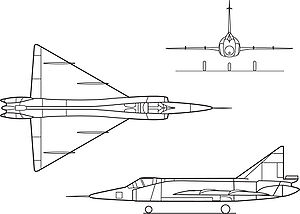 - Crew: 1
- Crew: 1
- Length: 68 ft 4 in (20.83 m)
- Wingspan: 38 ft 1 in (11.61 m)
- Height: 21 ft 2 in (6.45 m)
- Wing area: 695 ft² (64.57 m²)
- Airfoil: NACA 0004-65 mod root and tip
- Empty weight: 19,350 lb (8,777 kg)
- Loaded weight: 24,500 lb (11,100 kg)
- Ma takeoff weight: 31,500 lb (14,300 kg)
- Powerplant: 1× Pratt & Whitney J57-P-25 afterburning turbojet
- Dry thrust: 11,700 lbf (52.0 kN)
- Thrust with afterburner: 17,200 lbf (76.5 kN)
- Internal fuel capacity: 1,085 US gal (4,107 l)
- Eternal fuel capacity: 2 × 215 US gal (815 l) drop tanks
Performance
- Maimum speed: Mach 1.25 (825 mph, 1,304 km/h) at 40,000 ft (12,190 m)
- Range: 1,350 mi (1,170 nmo, 2,175 km)
- Service ceiling: 53,400 ft (16,300 m)
- Rate of climb: 13,000 ft/min (66 m/s)
- Wing loading: 35 lb/ft² (172 kg/m²)
- Thrust/weight: 0.70
Armament
- Rockets: 24 × 2.75 in (70 mm) FFAR (Folding Fin Aerial Rocket) unguided rockets in missile bay doors
- Missiles:
- 6 × AIM-4 Falcon air-to-air missiles or
- 3 × AIM-4 Falcon
- 1 × AIM-26 Falcon with conventional or nuclear warhead
Avionics
- MG-10 fire control system
- Century Series
Related development
- Convair F-92
- F-106 Delta Dart
Comparable aircraft
- CF-105 Arrow
- Dassault Mirage III
- Mikoyan-Gurevich MiG-19
- Mikoyan-Gurevich MiG-21
- Saab Draken
References
1. Knaack 1978, p. 169.
2. Wegg 2000, p. 200.
3. Knaack 1978, pp. 159–160.
4. Wegg 2000, pp. 200–201.
5. Knaack 1978, pp. 160–161.
6. Knaack 1978, pp. 163–164.
7. Gunston 1957, pp. 513–514.
8. a b Wegg 2000, p. 201.
9. Knaack 1978, p. 166.
10. Gunston 1981, p. 26.
11. Bush's Service in the Teas Air National Guard
12. Hobson
13. Hobson
14. Ron Yates Vietnam Remembrances
15. The Shooting Down of the Turkish F-102s
16. Baugher's F-102C
17. a b c Wegg 2000, p. 203.
18. Wings Over Rockies Air and Space Museum- F-102 Delta Dagger
19. Air-Britain's Photo Collection: F-102A
20. McChord Air Museum - F-102 Delta Dagger (56-1515) 317th FIS, 325th FW, McChord's First supersonic aircraft
21. Green, William and Gordon Swanborough. The Great Book of Fighters. St. Paul, Minnesota: MBI Publishing, 2001. ISBN 0-7603-1194-3.
Bibliography
- Drendel, Lou. Century Series in Color (Fighting Colors). Carrollton, Teas: Squadron/Signal Publications, 1980. ISBN 0-89747-097-4.
- Green, William. The World's Fighting Planes. London: Macdonald, 1964.
- Gunston, Bill. "Convair F-102: An Analysis of America's Home-defence Interceptor". Flight, 19 April 1957, pp. 512–518.
- Gunston, Bill. Fighters of the Fifties. North Branch, Minnesota: Specialty Press Publishers & Wholesalers, Inc., 1981. ISBN 0-933424-32-9.
- Hobson, Chris. Vietnam Air Losses: United States Air Force, Navy and Marine Corps Fied-Wing Aircraft Losses in Southeast Asia, 1961-73. North Branch,
Minnesota: Specialty Press, 2002. ISBN 1-85780-1156.
- Knaack, Marcelle Size. Encyclopedia of US Air Force Aircraft and Missile Systems: Volume 1 Post-World War II Fighters 1945-1973. Washington, DC: Office
of Air Force History, 1978. ISBN 0-912799-59-5.
- Pace, Steve. -Fighters: USAF Eperimental and Prototype Fighters, P-59 to YF-23. St. Paul, Minnesota: Motorbooks International, 1991. ISBN 0-87938-540-5.
- Wegg, John. General Dynamics Aircraft and their Predecessors. London: Putnam, 1990. ISBN 0-85177-833-.
- Winchester, Jim, ed. "Convair F-102 Delta Dagger." Military Aircraft of the Cold War (The Aviation Factfile). London: Grange Books plc, 2006.
ISBN 1-84013-929-3.
Page best for: convair f 102, convair f 102a
Living Warbirds: The best warbirds DVD series.
Source: WikiPedia